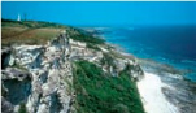Travel Reference
In-Depth Information
The Aguni passenger and vehicle ferry.
Dramatic cliffs at Aguni's Cape Fuden.
Aguni Sea Salt
(粟国の塩)
Who would have thought that making salt was so complicated? It's true that ordinary sea salts are
simply made by the evaporaion of sea water, usually in large man-made or natural pans, followed
by its collecion. But Aguni salt is no ordinary salt. First, the cleanest waters from the East China Sea
are piped in from a good distance offshore to the main plant. There, the seawater is pumped up to
the top of the tower and trickled down on to the leafless branches of young bamboo stalks, hanging
upside-down. This is repeated coninuously over the course of about a week. Due to the cinder-block
perforaions in the tower, the sea breezes gradually carry away the moisture, resulting in
kansui
, or
strong saltwater that has been condensed to six or seven imes its original volume. Moreover, the
salt adheres to the branches, crystallizing thicker and thicker. At the appropriate ime, the super-sat-
urated water and crystals are harvested and loaded into the firing pan to be boiled down with other
ingredients. At this stage, the salt develops a unique flavor, salty, of course, but much more so. It's
actually delicious. Now it's ime for soring out any impurities and packaging. The Aguni Plant ships to
buyers all over the world. As might be imagined, such salt is not cheap. Aguni-no-shio may be found
on all the gourmet spice and seasoning internet websites. It sells for $20-$25 for an 8 oz or one-cup
package.


